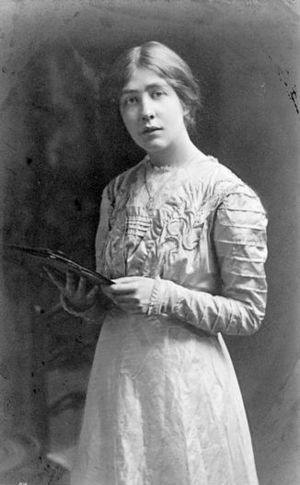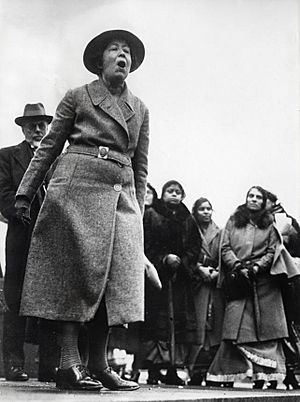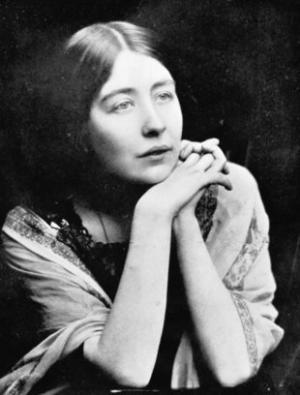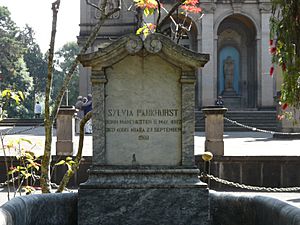Sylvia Pankhurst facts for kids
Quick facts for kids
Sylvia Pankhurst
|
|
|---|---|

Sylvia Pankhurst (1909)
|
|
| Born |
Estelle Sylvia Pankhurst
5 May 1882 Old Trafford, Manchester, England
|
| Died | 27 September 1960 (aged 78) Addis Ababa, Ethiopia
|
| Burial place | Holy Trinity Cathedral, Addis Ababa |
| Monuments | Sylvia Pankhurst (artwork) |
| Alma mater | Manchester School of Art Royal College of Art |
| Occupation | Political activist, writer, artist |
| Partner(s) | Silvio Corio |
| Children | Richard Pankhurst |
| Parent(s) | Richard Pankhurst Emmeline Goulden |
| Relatives | Christabel Pankhurst (sister) Adela Pankhurst (sister) Helen Pankhurst (granddaughter) Alula Pankhurst (grandson) |
Estelle Sylvia Pankhurst (born May 5, 1882 – died September 27, 1960) was an English activist. She fought for women's right to vote, a movement called suffrage. She was also a socialist and later became a strong supporter of left communist ideas. Sylvia worked against fascism and helped create an international language. She spent much of her later life supporting Ethiopia, where she eventually lived.
Contents
Sylvia Pankhurst's Early Life
Estelle Sylvia Pankhurst was born in Old Trafford, Manchester. Her parents, Richard Pankhurst and Emmeline Pankhurst, were very involved in women's rights. They later helped start the Independent Labour Party.
Sylvia and her sisters, Christabel and Adela, went to Manchester High School for Girls. All three became involved in the suffrage movement. Sylvia was interested in art from a young age.
She studied art at the Manchester School of Art. In 1900, she won a scholarship to the Royal College of Art in London. While studying there between 1904 and 1906, she noticed how unequal the art world was for women.
In 1912, Sylvia and her friends started the East London Confederation of Suffragettes. This group later became part of the WSPU.
Fighting for Women's Vote
In 1906, Sylvia Pankhurst began working full-time for the Women's Social and Political Union (WSPU). Her sister Christabel and their mother were also part of this group. Sylvia designed the WSPU logo, leaflets, banners, and posters. She also decorated their meeting places.
In 1907, she traveled through towns in England and Scotland. She painted pictures of working-class women in their jobs. She visited Leicester and helped set up a WSPU group there.
Unlike her mother and sister, Sylvia stayed connected to the labour movement. She focused her efforts on local campaigns. She helped create the East London Federation of the WSPU. Sylvia also wrote articles for the WSPU's newspaper, Votes for Women. In 1911, she wrote a book about the WSPU's fight, called The Suffragette: The History of the Women's Militant Suffrage Movement.
On November 1, 1913, Pankhurst spoke at the Royal Albert Hall in support of striking workers in Dublin. This event caused tension with her family. Her family felt her support for the Labour Party went against the WSPU's goal of being independent. Her sister Christabel even removed Sylvia from their union.
Sylvia was arrested 15 times while campaigning for women's rights. She was 24 when she first went to prison. Between February 1913 and July 1914, she was arrested eight times. During her hunger strikes in prison, she was fed against her will. She wrote about these difficult experiences. The WSPU gave her a Hunger Strike Medal for her bravery.
By 1914, Sylvia disagreed with the WSPU's methods. She wanted the WSPU to be a socialist group that worked on more than just women's suffrage. She wanted it to join with the Independent Labour Party. Her close relationship with Labour politician Keir Hardie was also a factor.
Because of these disagreements, she was expelled from the WSPU. She then started the East London Federation of Suffragettes in 1914. This group later changed its name to the Women's Suffrage Federation and then to the Workers' Socialist Federation. She started the newspaper for this group, Women's Dreadnought, which later became the Workers' Dreadnought. Her group also spoke out against World War I and helped hide people who refused to fight.
A Universal Language
Sylvia Pankhurst was also interested in creating an international auxiliary language. In 1927, she wrote a booklet called Delphos. In it, she explained why an international language was needed. She supported Interlingua, a language designed to be easy to learn. Her support for this language showed her belief in science and peace.
During the First World War
During the First World War, Sylvia Pankhurst was upset that her mother and sister strongly supported the war. She was against the war. Her organization tried to help women in poor parts of London. They opened "cost-price" restaurants to feed hungry people. They also started a toy factory to give jobs to women who were unemployed because of the war.
Sylvia and her friends also fought for soldiers' wives to get enough money while their husbands were away. They offered legal advice and campaigned to make the government help these families.
In 1915, Pankhurst strongly supported the International Women's Peace Congress. This meeting was held in The Hague. Her support for peace was very different from her mother's and sister's views.
Her Communist Beliefs
The Workers' Socialist Federation (WSF) became more involved in left-wing politics. They hosted the first meeting of the Communist Party (BSTI). Sylvia Pankhurst wrote an article called "A Constitution for British Soviets" for Workers' Dreadnought. In it, she talked about "Household Soviets" to make sure mothers and family organizers were represented in society.
The CP(BSTI) did not believe in working through parliament. This was different from the British Socialist Party, which formed the Communist Party of Great Britain (CPGB) in 1920. The CP(BSTI) joined the larger Communist Party, but not for long.
When the CPGB leaders asked Pankhurst to give them her newspaper, Workers' Dreadnought, she refused. Because of this, she was removed from the CPGB. She then started a new group called the Communist Workers Party.
She became a follower of left or council communism. She attended meetings of the Communist International in Russia and Amsterdam. She disagreed with Lenin about working with the British Labour Party. She supported other "left communists."
Her Family Life
Pankhurst did not want to get married or take a husband's name. Near the end of the First World War, she began living with Silvio Corio, an Italian anarchist. They moved to Woodford Green, where she lived for over 30 years. A blue plaque and a park named Pankhurst Green remember her connection to the area.
In 1927, when she was 45, she had a son named Richard. Because she refused to marry his father, her mother stopped speaking to her.
Supporting Ethiopia
In the early 1930s, Pankhurst moved away from communist politics. However, she remained active in movements against fascism and colonialism. In 1932, she helped create the Socialist Workers' National Health Council.
When Italy invaded Ethiopia, she started publishing The New Times and Ethiopia News in 1936. She became a strong supporter of Haile Selassie, the Emperor of Ethiopia. She raised money for Ethiopia's first teaching hospital. She also wrote a lot about Ethiopian art and culture. Her research was published in her book Ethiopia: A Cultural History (1955).
After Ethiopia was freed from Italian rule, she strongly supported Ethiopia and the former Italian Somaliland joining together. In 1956, she moved to Addis Ababa with her son Richard, invited by Emperor Haile Selassie. There, she started a monthly magazine called Ethiopia Observer. In it, she wrote about many parts of Ethiopian life and development.
Her Influence
Sylvia Pankhurst's writings greatly influenced British documentary filmmaker Jill Craigie. They sparked Craigie's interest in the women's suffrage movement.
Death and Recognition
Sylvia Pankhurst died in Addis Ababa in 1960, at age 78. She received a full state funeral. Emperor Haile Selassie called her "an honorary Ethiopian." She is the only foreigner buried in front of Holy Trinity Cathedral in Addis Ababa. This area is usually for heroes of the Italian war.
Her name and picture are on the plinth of the statue of Millicent Fawcett in Parliament Square, London. This statue was revealed in 2018. A musical about her life, called Sylvia, also opened in September of the same year.
Her Art
From a young age, Sylvia Pankhurst wanted to be an artist. She wanted to use her art to help with "great movements for social betterment." She studied at Manchester School of Art (1900–02) and then the Royal College of Art in London (1904–06).
For her work with the WSPU, she designed many banners, jewelry, and logos. Her design of an 'angel of freedom' became a popular symbol for the women's suffrage campaign. It appeared on banners, pamphlets, cups, and saucers.
An exhibition of her artworks was held at Tate Modern in 2013–14. Information and photos of her art are available through the Sheffield Hallam University Research Archive.
Pankhurst found it hard to balance her art with her political work. She eventually felt they could not go together. She once said, "Mothers came to me with their wasted little ones. I saw starvation look at me from patient eyes. I knew that I should never return to my art." By 1912, she had mostly stopped her art career to focus on her activism.
Her Writings
- The Home Front (1932)
- The Suffragette Movement: An Intimate Account of Persons and Ideals (1931)
- A Sylvia Pankhurst Reader, edited by Kathryn Dodd (1993)
- Non-Leninist Marxism: Writings on the Workers Councils (includes Pankhurst's "Communism and its Tactics") (2007)
- Education of the Masses (1918)
- E. Sylvia Pankhurst - Portrait of a Radical (1987)
Images for kids
See also
 In Spanish: Sylvia Pankhurst para niños
In Spanish: Sylvia Pankhurst para niños








